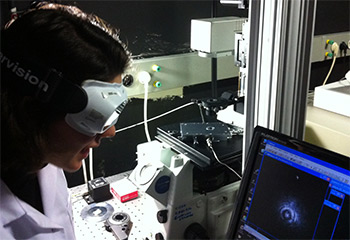Market leaders in temperature controlled microscopy, Linkam Scientific Instruments report on the use of their THMS600 temperature controlled stage in the study of metal-organic frameworks using Second Harmonic Generation Microscopy at the University of Leuven.
 Dr Karen Markey uses the Linkam THMS600 temperature stage
to study metal-organic frameworks.
Dr Karen Markey uses the Linkam THMS600 temperature stage
to study metal-organic frameworks.
The techniques most commonly used in microscopy have not changed much since its invention in the 16th century. But with the advancement but with the advancement of technology and the demand for more in-depth information, newer techniques such as Second Harmonic Generation (SHG) Microscopy are being used by scientists worldwide to further their research.
Dr Karen Markey from the University of Leuven, Belgium, is one such researcher who is reaping the benefits of these advancements by using SHG Microscopy to investigate the structure of materials in a manner that cannot be achieved through other, more conventional microscopy techniques.
Predominantly, SHG microscopy is used in the biological field because this technique allows for the imaging of samples, with non-centrosymmetric molecular structures, using contrast produced from the sample itself therefore negating the need to use dyes and colours which can damage living tissue. SHG can also achieve high resolution visualisation and even Three Dimensional imaging of the sample without needing to excite the molecules run the risk of it being subjected to photo toxicity – as can happen in techniques such as fluorescence microscopy.
Dr Markey and her colleagues in the university’s molecular electronics and photonics department have been using and fine tuning an SHG technique developed by Assistant Professor Monique van der Veen from the Technical University of Delft that can allow them to study the structure of metal-organic frameworks (MOFs). As part of this set-up, they have generally been using a wide field microscope and, more recently, a laser scanning microscope with an intense frequency of 800 nm. The team take several images of the same sample, but use different polarisations of the laser light. Plotting the variation of SHG intensity as a function of the polarisation gives an insight into the crystal structure of the samples.
With such small variations in optical density being of such importance, the control of the environmental conditions in which the sample is being held becomes even more vital. This was possible using a Linkam THMS600 stage.
Dr Markey was particularly impressed by the variety of parameters that can be controlled by the stages, she said:”You can easily set the desired temperature programs and also measure under N2 flow, which is important for the materials we work with. It is an ‘all in one’ solution.”
As these optical techniques evolve with time, more and more researchers in various fields will find a way to adapt them to their studies and therefore help paint a much clearer picture about the microscopic world.
To see the full paper on this application please visit: www.linkam.co.uk/application-notes.
Visit Linkam at www.linkam.co.uk and learn about the broad range of applications in the field of temperature-controlled microscopy.